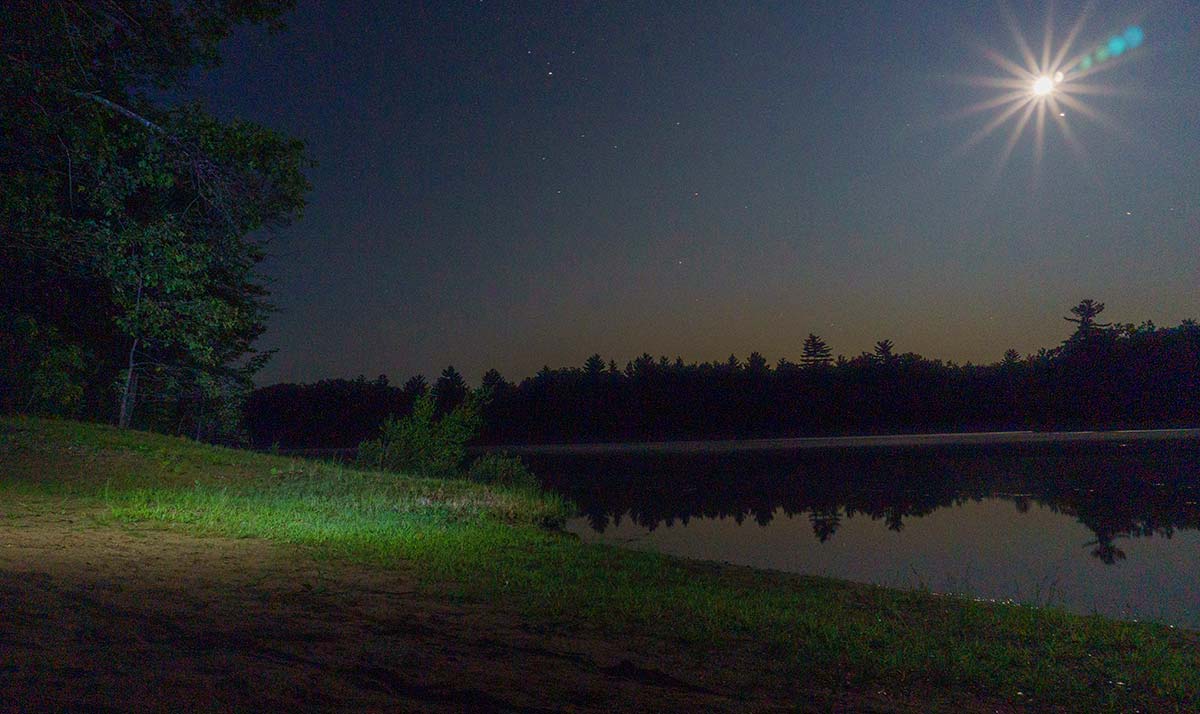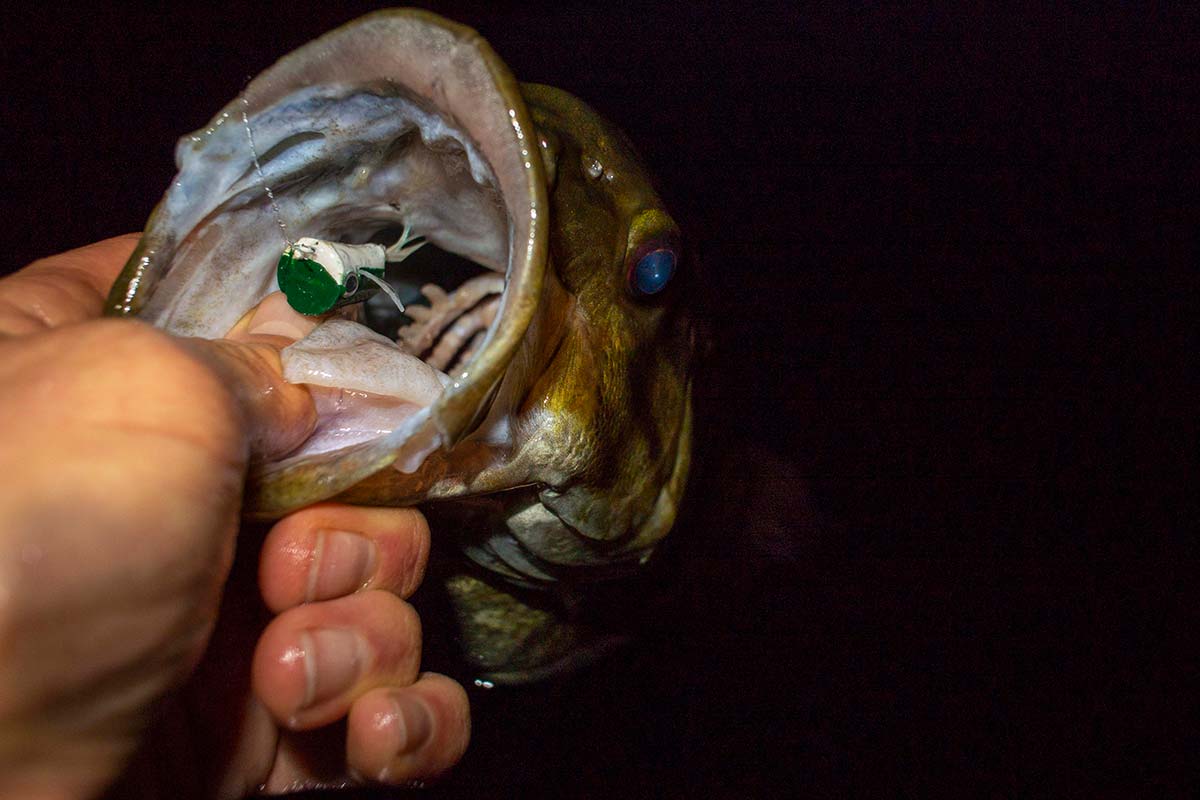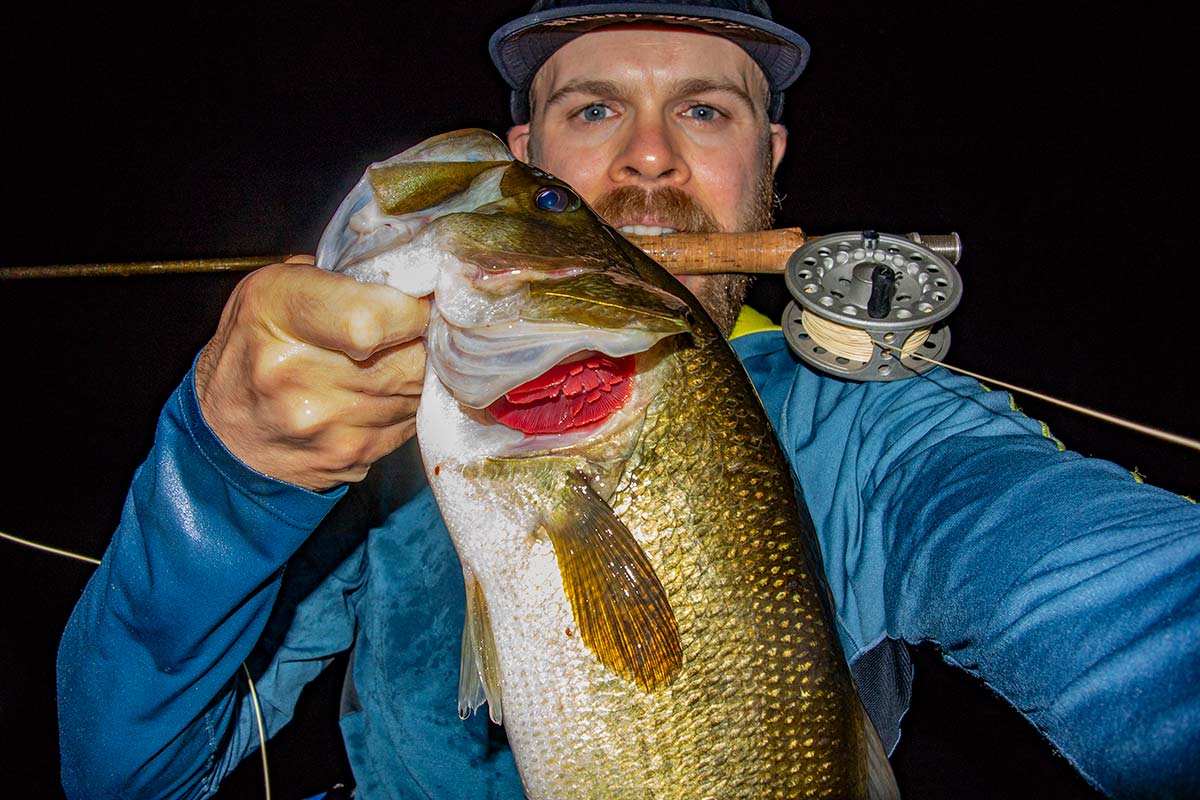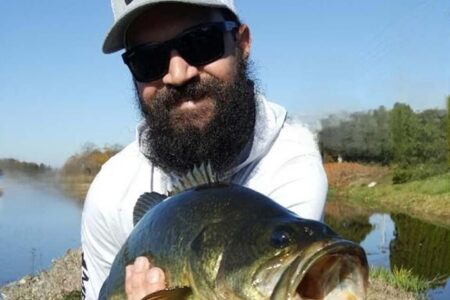
Now is the time to hit your local bass pond after the sun has set for a shot at a lunker largemouth.
In my fantasy world I’d live within walking distance to beautiful freestone rivers filled with huge wild trout. However, as is the case with so many of you reading this, my local waters are comprised mostly of ponds and small lakes. While it may take me 45 minutes to drive to the closest freestone trout river, I can be on the local bass pond in less than 10. This is what makes the largemouth bass both disrespected and revered—they are accessible to virtually everyone. Whether from shore, in a float tube, in a kayak or in a boat, there are near limitless opportunities to catch largemouth bass right around the corner from most everyone. For me, there is no better way to tangle with a big largemouth bass than on the fly at night.
One of the things I learned very quickly about fly fishing for bass was that I had the best success during the warmer months after dark. What I found was that the pond would be utterly dead during the day but filled with life at night. The combination of high water temperatures and bright sun, plus heavy pressure from other anglers, turned most of the bass off. However, at night during the summer bass move from deeper holding positions into the shallows to feed on a variety of baits; everything from mice to frogs and panfish and insects. The darkness makes them less afraid to come in close to shore, and the cooler nights also make them more aggressive. They may hang in deeper, cooler water during most of the hot summer days, but even when the temperatures are “bath water” they come in very tight to shore at night. This makes bass excellent targets for the fly rod with a traditional floating line, which is typically what many start out fishing with.
The number-one thing I look for at night in the summer is heavy structure: downed trees, docks, and weedy areas. Whether from shore or in the kayak, I cast right up tight to the cover. As I already mentioned, when the water temperatures cool slightly after dark the bass become more aggressive and willing to feed. However, in the height of the summer they are still often not overly ambitious in chasing down your fly. Therefore, I attempt to put my flies literally into the structure. You simply can’t be afraid to lose a fly, and be aggressive and precise with your casts. This particularly applies to sub-surface presentations; while they will follow a popper out of hiding, I often hook up on baitfish patterns very close to structure. Therefore, using flies that don’t sink quickly or get down deep is advisable this time of year as you’ll just get hung up a lot with those types of flies.

As for the retrieve, don’t be afraid to experiment. Generally I go slow and blend my fly in with the surroundings. Simply letting the fly “hang” in the area you believe the fish are holding can be very productive. Flies have the huge advantage over most lures in that they have a lot of inherent action without much angler-induced movement. That is, the feathers and hair undulate and “breath” with the slightest touch of the line or water movement, and you don’t have to keep constantly stripping the line to make them look alive. However, I prefer a little bit of a breeze and ripple on the water as it helps disguise my presence and that of the fly line; but not too much wind, or casting can become cumbersome. If it’s extremely calm, as it can often be at night in the summer, I work my fly very subtly. Yes, even poppers can be worked slowly with lots of time in a “dead drift,” letting your popper simply sit motionless.
As for the gear necessary to hunt bass on the fly at night, it’s about as basic as it gets in fly fishing. You absolutely do not need to go out and buy anything special; depending on my goals and the time of year, I fish with anything from a 6.5-foor 2-weight, all the way up to a traditional 9-foot 8-weight. If you are just starting out fishing for bass with the fly rod—day or night—I would suggest using whatever you have for a fly rod that is at least a 5-weight. In the summer I often use my 5- and 6-weights, but be forewarned that you will lose big fish with this light tackle, and casting larger flies can be tiring.
For example, one August I got onto a body of voraciously-feeding bass; they were crushing my flies and then dropping off of a flat into a mass of heavy weeds and lilies. They would dive into the mess of plant life and I lost several fish because I had insufficient lifting power with the 6-weight I was using at the time. Even pulling hand over hand on 8-pound tippet was insufficient to free these fly-rod bruisers; while I landed 26 fish that night to 5.5 pounds, I know I lost several of the largest because I couldn’t horse them. Therefore, if you’ve got an 8-weight rod and interested in catching 5-pound-and-up largemouth, I’d urge you to use your heavier gear!
As for leader and tippet, don’t worry about getting complicated here either. Do tapered leaders and tippet make it easier to deliver smaller flies to bass feeding on terrestrials at night like spiders and crickets? Yes, they do. However, do you need anything more than a straight section of monofilament? No! I typically use a straight 6- to 9-foot piece of 8-pound mono at night, but if I’m fishing around “sticky” structure or very weedy areas with an 8-weight I’ll bump that up to 12- or 15-pound. This makes it easier to horse fish in those first initial moments of the fight when it’s critical to get them out of the structure.

As for flies, I am very biased in my selection. I adore fishing poppers, almost to the point of obsession. I particularly enjoy using my own homemade cork poppers, so I typically reach for those first. However, any saltwater popper in sizes 2 to 2/0 will work; poppers like smaller iterations of Bob’s Banger or Rainy’s CB Bubble-Head. I think the “bass bug” poppers made by various different brands and tiers are on the small side for the typical largemouth, but they do work and are great for smallies. At night, I work my poppers slow, with lots of very long pauses. However, they typically get eaten immediately after the pop, so be prepared. There is absolutely nothing more exciting than sitting on a dead-still lake in the dark of night working a popper slowly and having a fish erupt on it. Deer hair flies like the Dahlberg Diver are also great, they push a lot of water and can induce big fish to strike. I like using them less like a popper and more like a wake bait, just slowly pulling them across the surface in starts and stops.
For subsurface presentations, the possibilities are endless. Flies that look like fish, crayfish, worms, salamanders and just about anything else on earth will work, and some of the flies designed for largemouth look pretty alien, too! However, I tend to reach for general baitfish patterns. You can’t go wrong with a Lefty’s Deceiver, but I like tall-bodied synthetic flies like UFM Baitfish and various Enrico Puglisi patterns. I typically go for simple, general patterns, and I like using flies with dark colors at night, regardless of the moon phase. However, I will admit I’ve also had great success with chartreuse flies at night. It could be due to my confidence in this color, but I find the fish really respond to some chartreuse in the body of the fly. During the day, I find that detailed patterns that look like the specific baitfish in the area can make a difference, however at night I do not seem to notice any difference between highly detailed flies and more general profiles. It’s more about presenting it to them in a life-like way in then places the bass are feeding or waiting in ambush than to perfectly mimic a specific prey item. I’ll also note that I’ve had some very fun nights presenting size six wooly-buggers to fussy bass; sizing down can sometimes make a difference with highly pressured bass.



